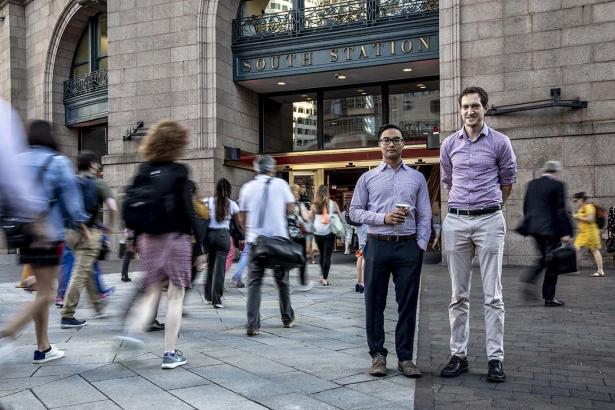BOSTON — One Sunday night two years ago, Marc Ebuña and Ari Ofsevit stayed up past 1 a.m. to watch the city’s transit system grind to a pointless halt.
Sitting in their respective apartments, they were monitoring a website that tracks Boston’s rapid-transit trains in real time. “I live-tweeted the late-night ballet, the last-trains ballet,” Ebuña says. Except what they were seeing was more of a citywide muscle spasm than an elegant dance.
On that September night in 2016, Ebuña and Ofsevit could see the last trains on the Red, Orange and Blue lines, and the westbound Green Line streetcars, as they reached downtown transfer stations and stopped. The only trains still moving were two lonely streetcars on the Green Line’s E branch. Nothing could move until these two stragglers reached Park Street. Across Boston, Ebuña and Ofsevit knew, 56 buses, many carrying tired shift workers, were idling outside stations, awaiting the trains’ arrival before they fanned out with their last passengers. For a quarter-hour, the Green E trains had held up the entire system.
Ebuña took screenshots and fired off a tweetstorm that night. Ofsevit blogged about the 1 a.m. bottleneck the next afternoon. Another member scraped daily data off a transit website that tracks MBTA trains. The numbers showed that the last Green E train caused about 75 percent of the delays in the transit system’s nightly shutdowns. James Aloisi, TransitMatters’ token baby boomer and a former state secretary of transportation, announced the group’s findings in a magazine op-ed headlined, “Shutdown process costly for the T.”
Three months later, after initially trying to discredit the article, MBTA officials acknowledged that the last Green E train of the night carried, on average, one person. One person! Sensibly, officials announced that the other trains would no longer wait for the laggard streetcars. TransitMatters had saved the MBTA, or the “T,” as it’s known by everyone in Boston, most of the $500,000 it was spending per year on the late shutdowns. They’d also shortened the early morning journeys of countless fellow passengers. “It took a little bit of internal calculation for them to realize: ‘No, wait a second, these guys are right!’” says Ebuña.
Over the past three years, Ebuña, Ofsevit, and their comrades in transit-nerdiness have emerged as leading voices in the debates over how to improve Boston’s beleaguered transit system, which runs the oldest train and bus fleets among the nation’s major transit agencies and faces a $7 billion backlog of repair and upkeep work. TransitMatters, run mostly by millennials and using everything from encyclopedic knowledge of train schedules to a network of government insiders, has scored several wins with its data-driven proposals to improve the MBTA’s service. This year, TransitMatters’ advocacy persuaded the MBTA to launch overnight bus service for the first time in decades. Members of the group also played a major role in persuading the city and state to add a bus lane to the design for a renovated bridge over the Charles River between historic Charlestown and downtown—a change that will speed up some of the T’s most popular, overcrowded and often-gridlocked bus lines.
With success has come a more receptive response from the transit officials who once pooh-poohed their findings. “They’ve been terrific in asking us to think about things differently,” says Joseph Aiello, chairman of the Fiscal and Management Control Board, a governor-appointed panel that oversees the T for the state department of transportation. “The board and staff listen to them very carefully. We don’t always agree with them, but we frequently adopt their work.”
In Boston, a town stocked with more than a dozen major universities and colleges and full of urbanists and transit enthusiasts—the kind of people who actually get together over beers just to geek out about transportation policy—Ebuña, 31, and Ofsevit, 34, have become spokespeople for the city’s younger generation of transit riders: millennials who’ve rejected suburban life to go car-free or car-light in the city, who track the T’s open-source data via smartphone to gain a speedier edge on their commutes. “I think as millennials, we see the folly of the previous generation’s emigration to the suburbs,” says Ebuña. Instead, they want to revitalize urban life in fast-growing Boston by improving how people get around. They’re not making small-bore changes, like organizing car pools or encouraging bike commuting, or griping about fare increases. They’re challenging an entrenched and cumbersome bureaucracy that should be one of the most innovative sectors of big-city government, but isn’t. And their talent for collaboration with change-skeptics in the corridors of government serves as a model for how motivated outsiders can help drive quality of life improvements in cities around the world.


Spread the word